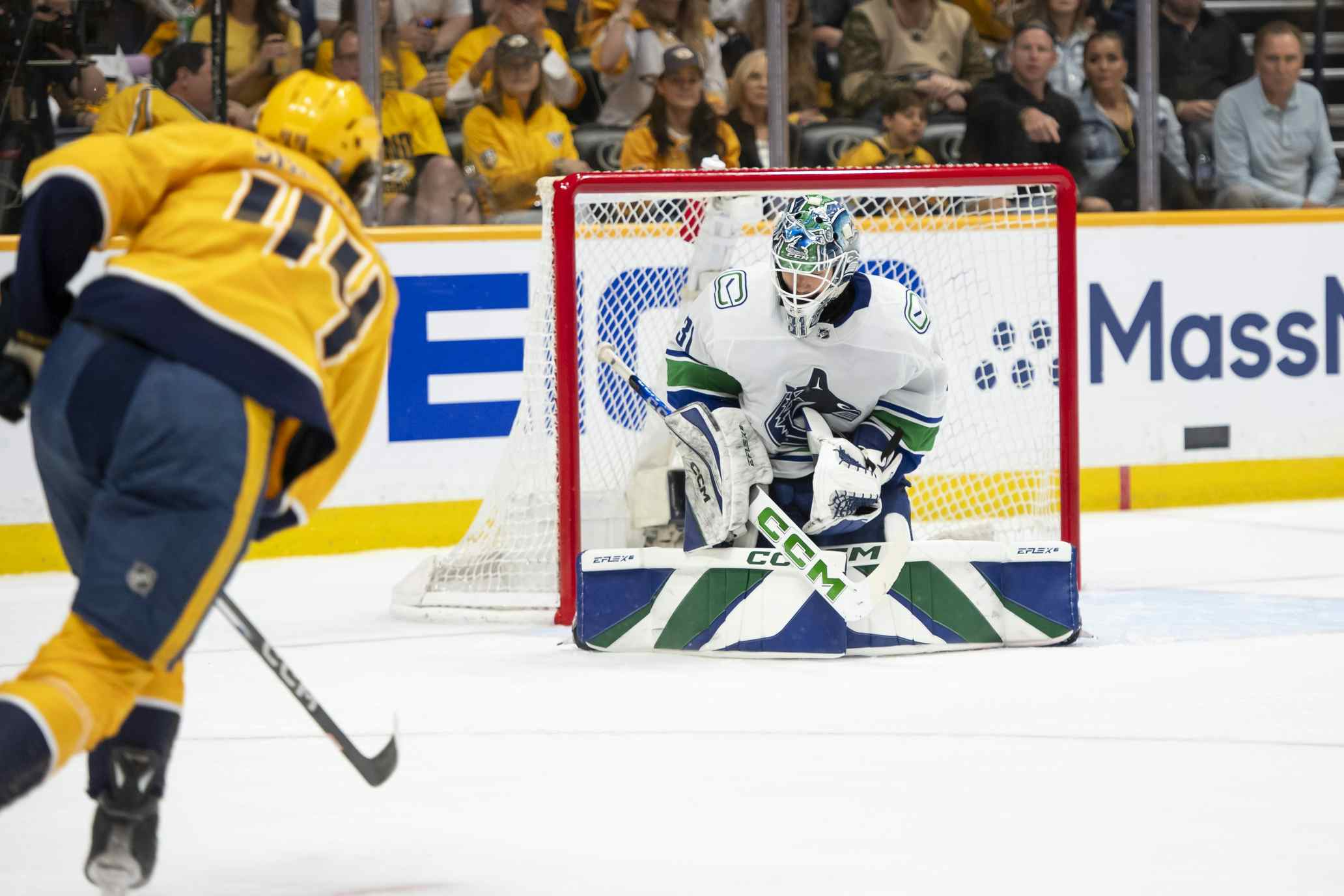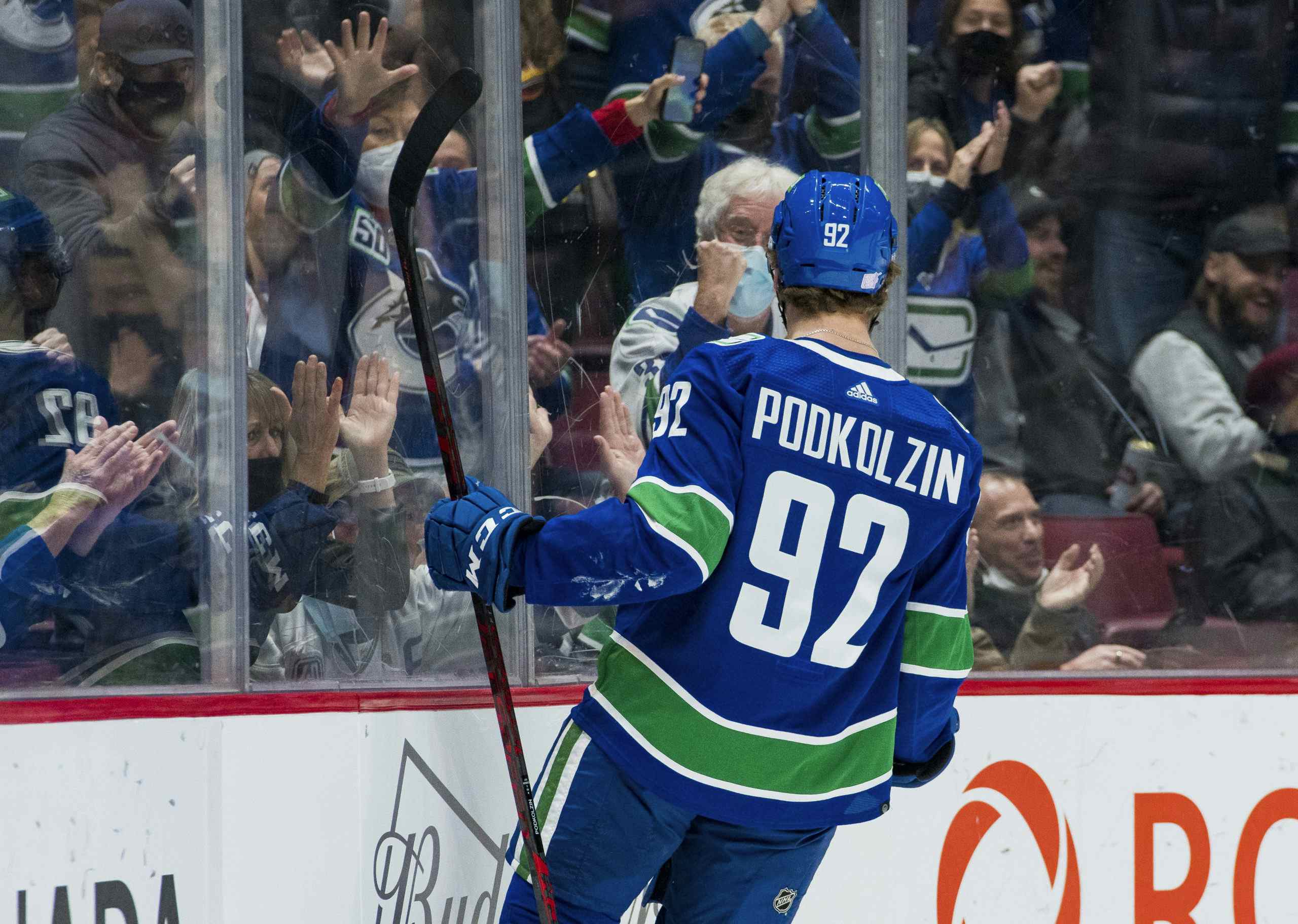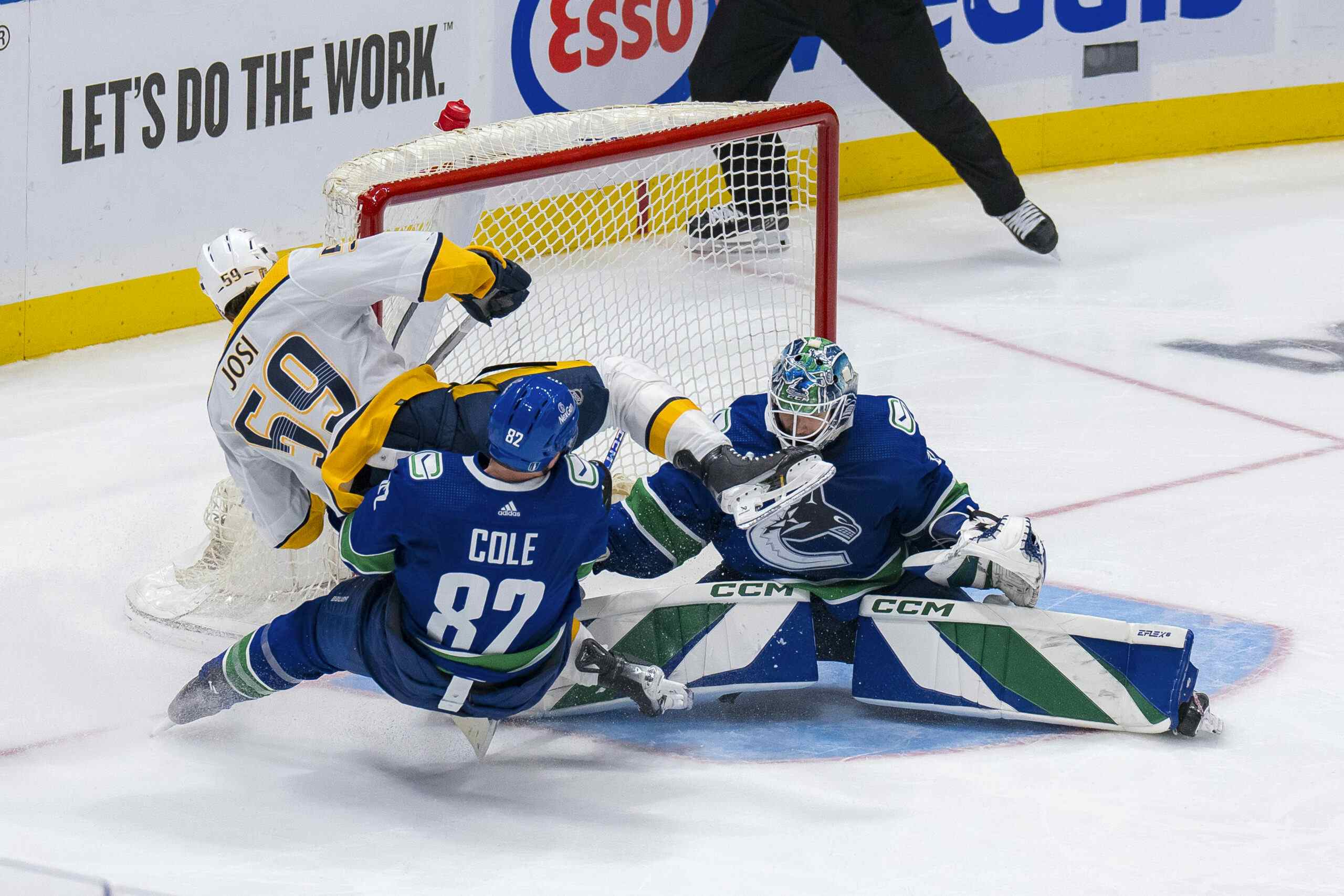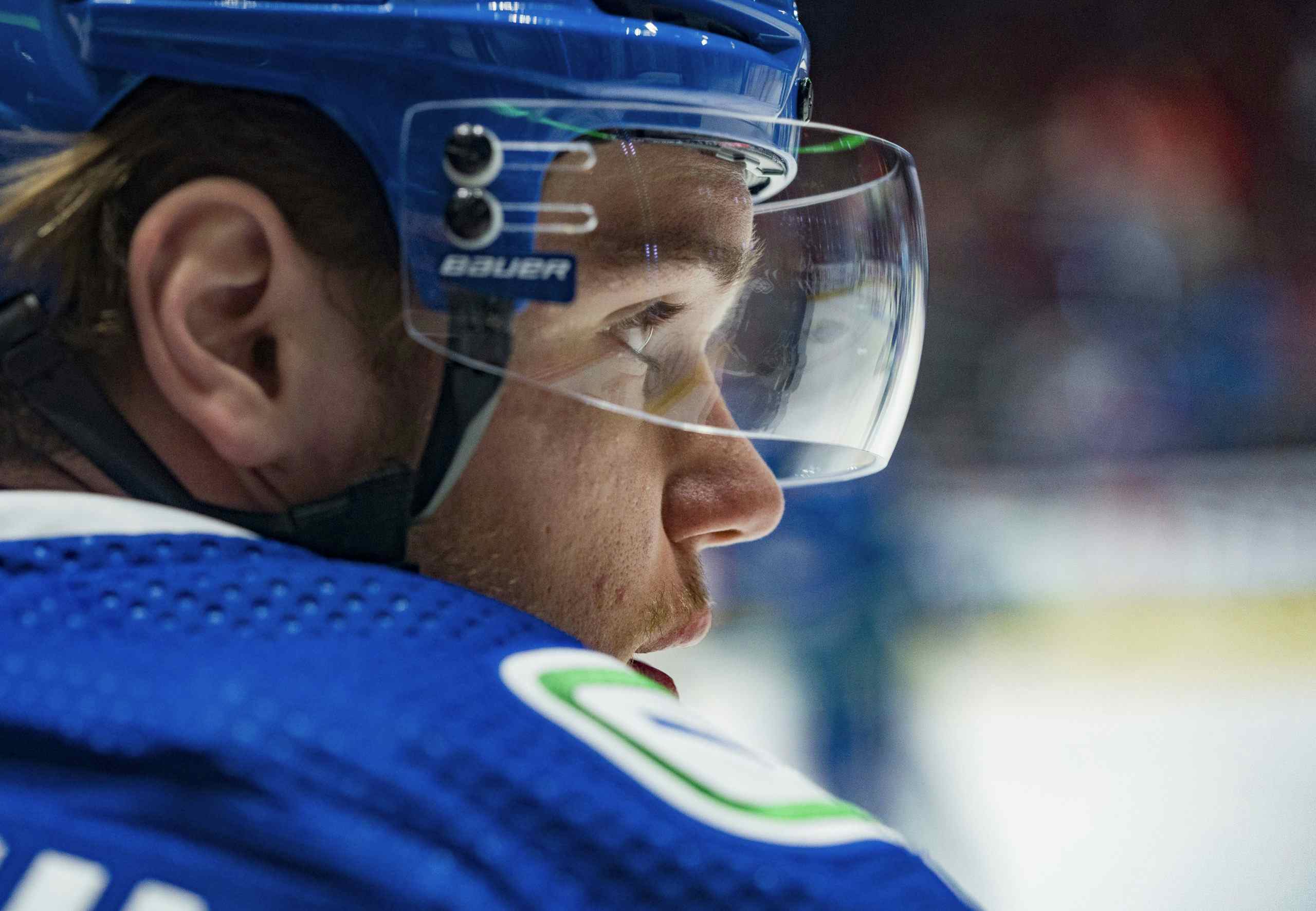Canucks Douse the Flames, get into the win column: recap and chance data
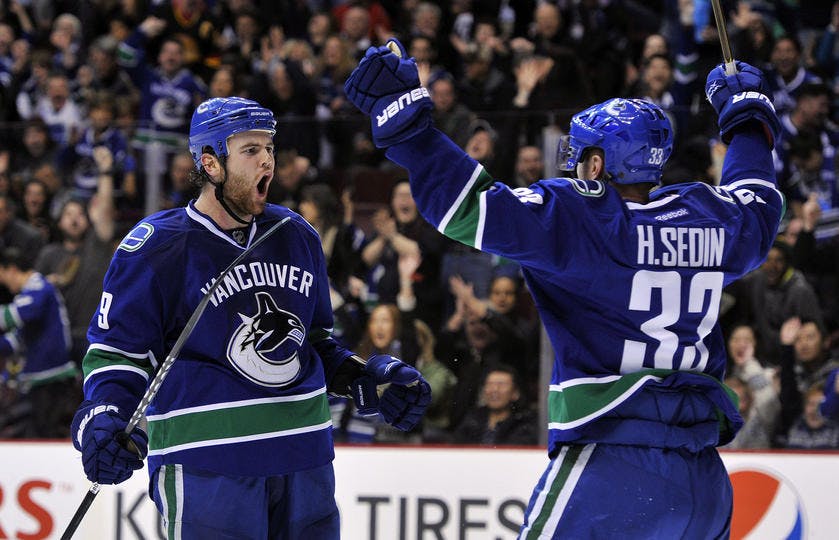
Zack Kassian’s pumped. As well he should be.
Photo Credit: Rich Lam/Getty Images
Vancouver’s three game homestand started out with a gong show performance in the season opener against Anaheim, but it ended triumphantly (I guess) with a shootout win on Wednesday night over the Calgary Flames. If we’re being honest, Vancouver has lost a game and tied two others so far on the season and they’ve given up two goal leads in each of those ties… But whatever, the Canucks got into the win column in their third game of the season and that should help ease some of the panic in this market.
It wasn’t pretty, especially in a low-event first period in which you could’ve heard a pin drop in the mausoleum-like confines of Rogers Arena. But two points is two points, and as the Canucks struggle to tread water in the early going this season (while they await Ryan Kesler’s return to the lineup) that matters a whole lot.
Read on past the jump for scoring chance data, and some analysis.
– We’ll begin, as we usually do, with the most important numbers. The Calgary Flames out-chanced the Canucks 18-13 overall, 14 to 11 at even-strength and 12 to 11 with the score tied. To the eyes, Cory Schneider looked shaky in this contest, but he was nails in the third period, over-time and the shootout. Schneider provided the goaltending that a short-handed team like the Canucks require to win games at the moment. The Canucks, I might add, are now -13 in scoring chance differential in three games so far this season. That’s a much bigger concern to me than their recent inability to hold two goal leads.
– Let’s dig a bit deeper into Schneider’s numbers. On the evening he stopped 34 of 36 shots against, and stopped 12 of 14 tough shots against (defined as scoring chances on net). His puck-handling didn’t inspire confidence and in the third period the Flames started testing him from cheesey angles (which suggests to me that Bob Hartley considered Schneider liable to give up a McSofty) but no matter, he played really well tongiht.
– Vancouver’s defense, no so much. Kevin Bieksa – who had a tough game overall and nearly scored an own goal on Schneider on a goal-mouth scramble early in the third period. Alex Edler’s adjustment to playing the right-side point didn’t directly cost the club a goal against at even-strength (which is an improvement over the previous couple of games), but he made some poor reads in the third that led to turnovers and scoring chances against. Jason Garrison and Dan Hamhuis were mostly solid, though Garrison took the first in a parade of minor penalties by Vancouver’s blueliners that allowed Calgary to get off the matt late in the second frame while Hamhuis mis-played a two-one one on Tanguay’s goal. This blueline group has the makings of a very solid unit, but that hasn’t really showed up for the Canucks in the early going. Mostly, I think, it’s just a lack of discipline and some bad luck on the bounces.
– I’d like to make a quick point about Jason Garrison who already reads the Sedins like he’s played with them for years, something I find extremely impressive when you consider that Wednesday night’s game was only his third as a Canucks, and the team only held an accelerated one week training camp. In one of my favorite pieces of hockey blogging over the past 18 months, Justin Bourne wrote this about how Vancouver’s offensive players adjust to playing consistently with the twins:
The coolest thing about that is, their teammates (especially Alex Burrows, and especially their powerplay unit) have come to expect [the twins weird back door passes], so now they take the extra second to find the open guy, not just The Guy They’re Supposed To Pass To. Its opened everyone up creatively.
Jason Garrison hasn’t tallied yet in a Vancouver uniform, and didn’t really find an opportunity to uncork his heavy artillery on Wednesday night. But it’ll come. I’ve really liked what I’ve seen so far.
– Though they didn’t have a particularly high-event game, the Sedins and Kassian were dynamite on the cycle.. Zack Kassian, who will obviously get his own bullet point in a moment, is a monster down-low and won fifty-fifty puck battles with consistency in the offensive end. Needless to say, this top-line has an awful lot of potential and hopefully they’ll get a few games to really grow accustomed to playing together.
– Zack Kassian’s fitness level and speed has noticeably improved this season (75 second offensive zone shifts, what?). But so has his on-ice maturity. He took a somewhat undisciplined penalty running Kipprusoff early in the third (though if you’re going to take a minor penalty, you might as well make sure the opposition’s goaltender feels it) but I was very impressed with his zone-exit passes, his directing traffic in the defensive end and the fact that he made sure to finish every check, every opportunity he got. He even schooled up some pretty capable tough minutes defensemen in Mark Giordano and Jay Bouwmeester down low in the offensive zone. Put simply: he played a punishing game.
– Oh and that goal. What a beauty. Kassian faked a shot which drew Kipprusoff way out of his net as Kassian skated behind the goal, brought the puck back to his forehand with a graceful toe-drag and very nearly tucked the puck into the far-side of Calgary’s cage on the wrap around. How close did he come to finishing the play right then and there? This close:
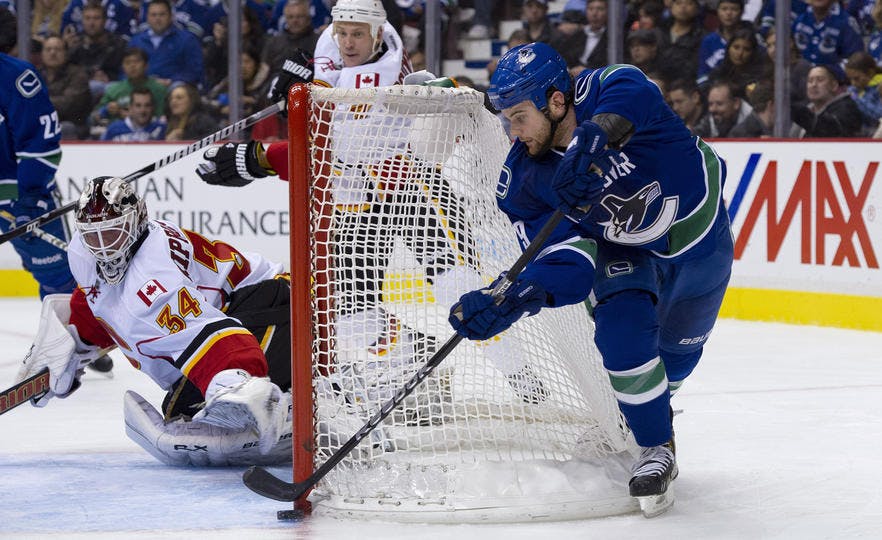
Photo Credit: Rich Lam/Getty Images
Luckily for Kassian, the puck got stuck between two Flames defender and Mark Giordano tried (and failed) to clear the puck with his hand. The puck ended up back on Kassian’s stick and he got two whacks of it the second of which ended up behind Kipprusoff for the game’s opening goal. The goal was unassisted and that shift was absolutely dominant. Oh and Zack Kassian turns twenty-two on Thursday, so that’s pretty cool. Here’s the goal:
Video courtesy CanucksHD
– The Alex Burrows at center experiment was, I think, a qualified success. Burrows lost his first two face-offs this evening (both of them in the first period) but won five of his next six to finish with a 63% success rate in the face-off dot. On top of that, he recorded two chance assists (both of them in the first period, on lovely passes to Jannik Hansen), took a scoring chance and then scored on his usual move in the shootout. No one is going so far as to describe Burrows as, say, the answer to Vancouver’s third-line center need (at least not on the strength of one quality outing) but he’ll work as a bandaid in the short-term in that spot, I think.
– Mason Raymond had a hell of a game, setting up three scoring chances (unfortunately two of those chances were to Dale Weise who missed the net by a lot) and taking one as well (on the goal he scored). His power-play snipe over Kipprusoff was just gravy though, much more impressive was his ability to cycle in the offensive end and use his speed effectively in puck battles. He looked, dare I say it, strong on his skates on Wednesday. Great sign for the Canucks.
– A couple Flames notes because why not? Mikael Backlund is very, very good and Alex Tanguay is one of the best pure snipers in the NHL (and has been for a while). Both of those guys can play on my team any day of the week.
– Finally Jordan Schroeder’s NHL debut was unspectacular, but he looked reasonably competent. On his first shift he won a face-off, threw a hit and made a nifty play on a zone-exit. On his second, however, he took a really dumb holding penalty a hundred feet and change from Vancouver’s net. Still, he played nearly fifteen minutes and acquitted himself reasonably well, though he didn’t generate much in the way of offensive looks.
Canucks individual chances:
| Chances Taken | Chance Assists | Total | |
|---|---|---|---|
| Jannik Hansen | 3 | 1 | 4 |
| Mason Raymond | 1 | 3 | 4 |
| Alex Burrows | 1 | 2 | 3 |
| Dale Weise | 2 | 0 | 2 |
| Zack Kassian | 2 | 0 | 2 |
| Henrik Sedin | 1 | 1 | 2 |
| Daniel Sedin | 0 | 2 | 2 |
| Jason Garrison | 1 | 0 | 1 |
| Keith Ballard | 1 | 0 | 1 |
| Kevin Bieksa | 0 | 1 | 1 |
| Dan Hamhuis | 0 | 1 | 1 |
Total chances by period:
| 1st | 2nd | 3rd | OT | Total | |
|---|---|---|---|---|---|
| VAN (EV) | 4 (4) | 5 (3) | 4 (4) | 0 (0) | 13 (11) |
| CGY (EV) | 4 (3) | 5 (2) | 6 (6) | 3 (3) | 18 (14) |
Recent articles from Thomas Drance

